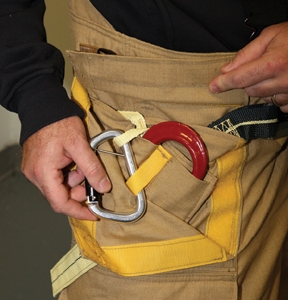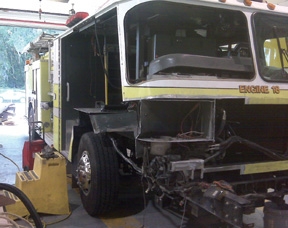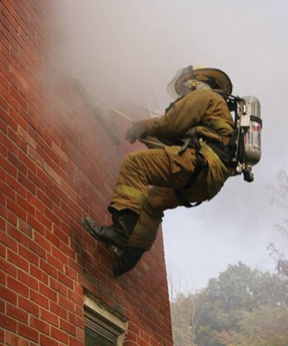 |
 |
| RIT Rescue Systems makes the PRESS (Pre-Rigged Emergency Safety System) for firefighters to equip them with the necessary hardware and rope to safely bail out. (Photos courtesy of RIT Rescue Systems.) |
 |
| Lion makes a personal rescue system comprising a Class II harness in its bunker pants, a tether, a descent control device, a carabiner, and 50 feet of rope. (Photo courtesy of Lion Apparel.) |
 |
| Lion’s Class II harness is completely enclosed in its bunker pants, only exposing an attachment point at the front of the pants. (Photo coutesy of Lion Apparel.) |
 |
| A firefighter uses a RIT Rescue Systems Class II harness and PRESS system to bail out of a building. (Photo courtesy of RIT Rescue Systems.) |
The use of personal escape systems for firefighters has seen a marked increase in the past few years, with manufacturers designing and making easier-to-use, more comfortable, and more robust harnesses and bailout systems.
More recently, personal protective equipment (PPE) makers have moved in the direction of fully integrating personal escape belts, harnesses, and their ancillary systems into bunker pants, with the goal of making their designs bulletproof in terms of always being at the ready the moment a firefighter dons his gear.
Alan Schierenbeck, senior product specialist for Honeywell First Responder Products, says that the first bunker pants-integrated Class II harness was developed in the late 1980s by Morning Pride, a company subsequently purchased by Honeywell.
“That was the only successful integrated harness for the better part of 20 years until around 2008, with the introduction of new products by various makers,” Schierenbeck says.
He notes that, at that time, Honeywell brought together three of its regional sales managers and three independent personal rescue experts to Dayton, Ohio, to spend three days using and assessing all of the harnesses on the market.
“They spent their days bailing out of windows, then discussing their experiences and doing it again and again,” Schierenbeck says. “When they finished their sessions, they put together 12 design goals that became Honeywell’s new integrated harness in 2009.”
Schierenbeck points out that Honeywell’s Class II Spider Harness System is Underwriters Laboratories (UL)-certified to National Fire Protection Association (NFPA) 1983, Standard on Life Safety Rope and Equipment for Emergency Services (2006 ed.) and its components are UL-certified to NFPA 1971, Standard on Protective Ensembles for Structural Fire Fighting and Proximity Fire Fighting (2007 ed.).
The waist belt on the harness is made of Kevlar® and is external on the bunker pants for easy access and installation. The leg loops are placed between the shell and liner to make the system snag-free.
The harness closure system is mounted to the pants with a D ring on the fly and a snap hook on the left front pants panel.
“Donning and doffing the pants are done just like regular bunker pants,” Schierenbeck says. “It’s so intuitive, firefighters take to it immediately because there’s no learning curve with it. It’s no different in how they currently fasten their bunker pants. We thought that the easier it is to don the system, the more likely it would be worn correctly and be ready to go when needed.”
Schierenbeck notes that the Spider belts and harnesses are custom fitted by pants waist size and that the internal leg loops can be adjusted while being worn by using an external strap. He adds that leg loops can be placed on the outside of the bunker pants if a department requires such a design. The harness’s waist belt is always on the outside of the pants.
Honeywell also makes a Patriot Class II harness that allows wearers to adjust the belt and leg loops while wearing the pants. The Patriot can be used with an optional tether and also has the optional interior or exterior leg loops.
All of Honeywell’s harness systems employ a sliding D ring on the belt, which serves as the permanent location to attach the escape system hardware. As soon as the pants are pulled on, the bailout system is ready if needed.
Rob Freese, senior vice president of marketing for Globe Manufacturing Company, says that six years ago, when Globe was developing its GXtreme bunker gear, it was able to apply lessons learned about body mechanics to firefighting clothing and do a better job of incorporating a harness system into the bunker pants.
“Some complaints we heard were that the harness loops on the outside of the gear got hung up on projections and equipment, as well as the fact that the nylon and polyester used in most harness construction were susceptible to heat and flame,” Freese says. “We took that feedback and two years later were able to put an entire harness into our gear.”
Freese notes that the leg loops used in Globe’s IH Pants Class II harness are sized to the pants, depending on waist and inseam dimensions.
“When a firefighter is hanging in our harness, it creates an A-frame effect that comes up into the line of sight, instead of being at waist level,” Freese points out. “With the leg loops floating on the waist belt, it creates a seat harness inside the shell and liner system.”
All the working parts of the IH Pants harness system are made of Kevlar® fabric and sheathed inside the bunker pants, except for the attachment point. Globe offers two closure types on the harness and pants—a hook and D ring and a flat metal buckle, similar to a seat-belt buckle. The IH Pants Class II harness is certified to meet rope, harness, and structural standards of the NFPA, Freese adds.
The Globe Series 2 harness has a large D carabiner attached that is connected to the descent control device and a length of rope. The Series 1 harness is a simpler version with a pair of fabric ears in front where the user can attach a descent device.
“Personal escape systems have been growing in popularity across the fire service,” Freese observes. “Fire departments are taking a hard look at the systems out there and coming up with policies and procedures to use harnesses as multiuse types of devices. They have value to a fire department not only for personal escape but also as a ladder belt and for fall protection.”
Freese points out that some departments have used Globe’s Series 2 harness with a large carabiner to hook onto a down firefighter and use the harness as a drag-rescue device.
“It allows the rescuing firefighter to use his larger lower leg muscles and to have his hands free,” Freese notes.
Karen Lehtonen, director of products for Lion, says her company makes a Class II harness integrated with its bunker pants.
“The harness is made of Kevlar webbing, integrated between the outer shell and the lining of the pants,” Lehtonen says. “The webbing comes out of the outer shell through openings to allow access to the closure system and the anchor point on the harness, but the waist belt and leg loops are otherwise entirely enclosed.”
The Lion harness meets NFPA harness and structural standards, she says.
Lion uses a hook- and D-style closure for the pants and harness, Lehtonen observes, “because it’s the easiest method of closure and the surest way for a firefighter to know it’s engaged properly.”
Lion also offers a Personal Rescue System, comprised of its Class II harness in the bunker pants, a tether, a descent control device, a hook or carabiner anchor, and 50 feet of rope. Lion uses CMC Rescue Equipment’s Escape Artist descent control device in the system.
“Our bunker pants have specifically designed pockets to house the system and make it easier to access and carry,” Lehtonen notes. “There’s no extra bag to hang on the belt because the system interfaces directly into the pockets.”
In addition, Lion makes an NFPA 1983-compliant escape belt with Kevlar webbing that can be integrated with bunker pants through a series of belt loops.
The NFPA will publish an updated 1983 standard at the end of this year.
Lehtonen says Lion has seen a growing popularity for personal escape systems, especially in New York and the surrounding region.
New York passed statewide legislation in 2008 that requires fire departments to have personal escape systems for firefighters. The types and heights of buildings in the department’s response area and mutual-aid-response area will dictate what its risk assessment is and what would be required in terms of personal escape systems.
“But, besides New York, we’ve seen interest in these systems from around the country,” Lehtonen adds. “Fire departments have a high level of interest in providing some type of bailout system for their firefighters.”
Dan Mooney, vice president of RIT Rescue Systems, says RIT offers a single-belt escape harness, a Class II Kevlar or nylon escape harness, a full body Class II technical rescue harness, and a PRESS unit (Pre-Rigged Emergency Safety System).
“The PRESS is pocket-mounted and incorporates everything needed to bail out safely,” Mooney says. “Many departments specify our system in their turnout gear when they order personal protective equipment from manufacturers.”
He notes the PRESS can be either an individual system or a rescue system that is put on over a bunker coat. The system offers several options of descending devices, escape lines, anchor carabiners, and Crosby hooks.
John Evans, marketing director for Petzl USA, says his company offers the EXO personal escape system for use with various harness configurations.
The EXO includes a multipurpose anchor hook, a self-braking descender, a carabiner, and 50 feet of 7.5-mm Technora rope that resists flame, high temperatures, and abrasion and is cut-resistant. The entire system is contained in a Nomex bag that’s worn on the belt.
“It’s important to have the hook easily available, so our pouch has a dedicated slot for the hook that keeps it ready to use and prevents it from getting tangled,” Evans says. “You don’t want to put the hook in the pocket of your bunker pants because you want it available for quick access.”
Evans notes that part of Petzl’s system is that it doesn’t sell the product without a training component.
“We have 30 authorized dealer-trainers around the country and you have to get our system through one of them,” he says. “This is a highly specialized piece of gear, and proper training is part of our package.”
The EXO was first deployed in 2006 by the Fire Department of New York (FDNY), which collaborated on its development.
Sterling Rope Company offers a lightweight, low-profile, autolocking device for bailout called the F4. It allows a firefighter to make a hands-free bailout if necessary, according to Sterling president Carolyn Brodsky.
The F4 is certified to NFPA 1983 and also as a personal escape system when used with FireTech rope and a Crosby hook, which is the system FDNY uses.
The rope is prerigged by threading it through the F4’s four holes, then passing through a release handle, which, when squeezed, releases the rope to allow horizontal movement or descent. Although the F4 is autolocking to allow a hands-free bailout, Brodsky notes that firefighters still must use both hands to operate the device—one hand on the F4 and the brake hand on the free end of the rope to control the speed of descent.
ALAN M. PETRILLO is a Tucson, Arizona-based freelance writer who writes for national and regional magazines and newspapers and is a member of the Fire Apparatus & Emergency Equipment editorial advisory board. He served 22 years with the Verdoy (NY) Fire Department, including in the position of chief.
More Fire Apparatus Current Issue Articles
More Fire Apparatus Archives Issue Articles

